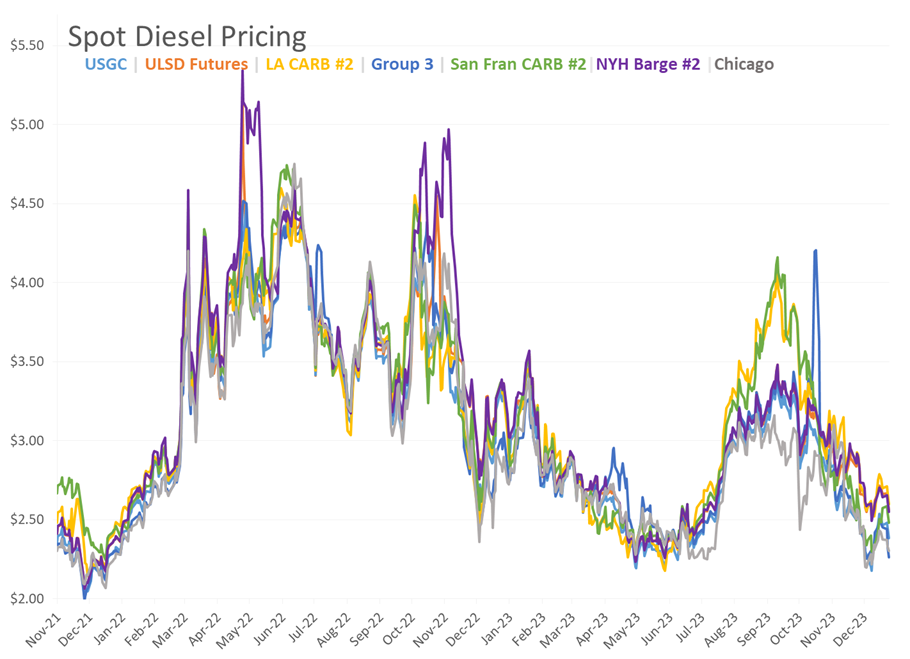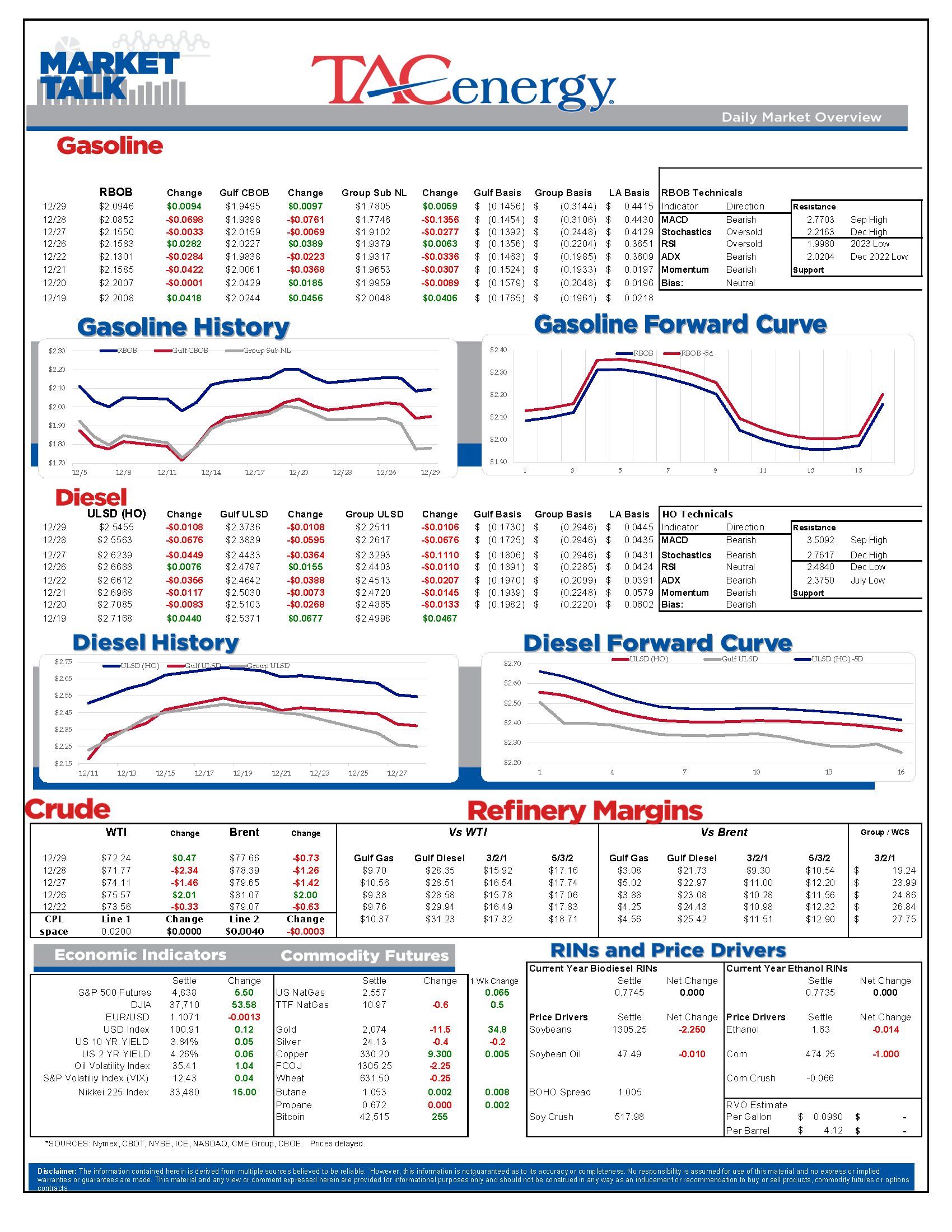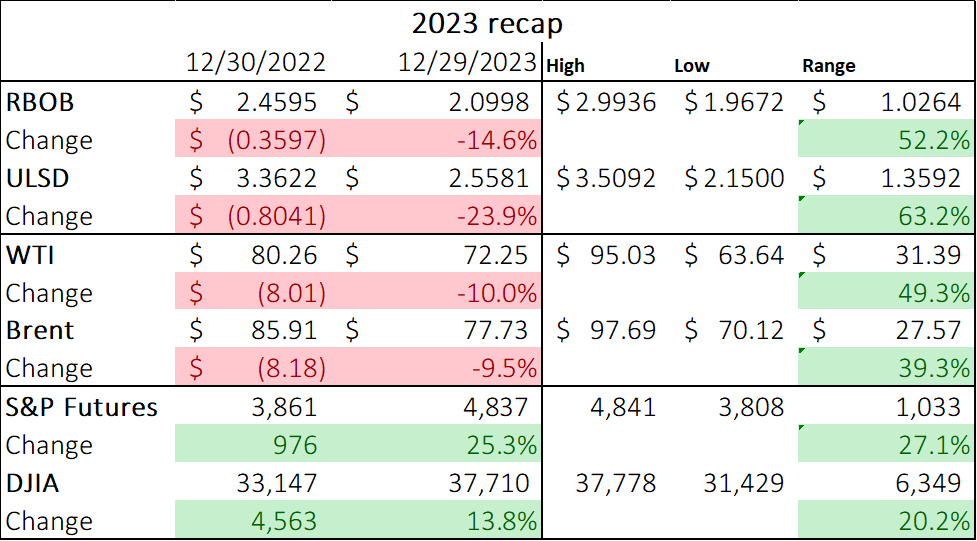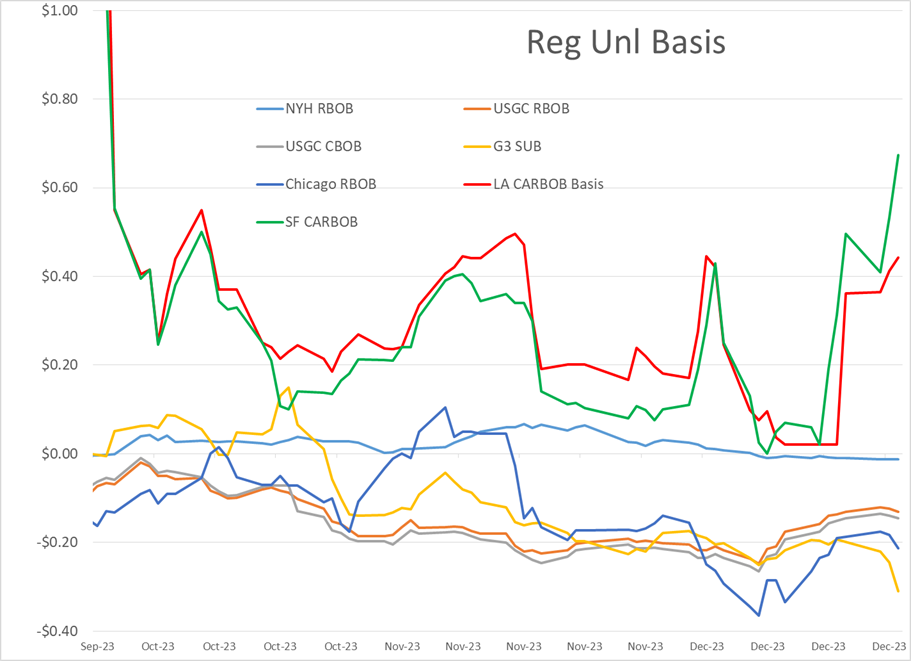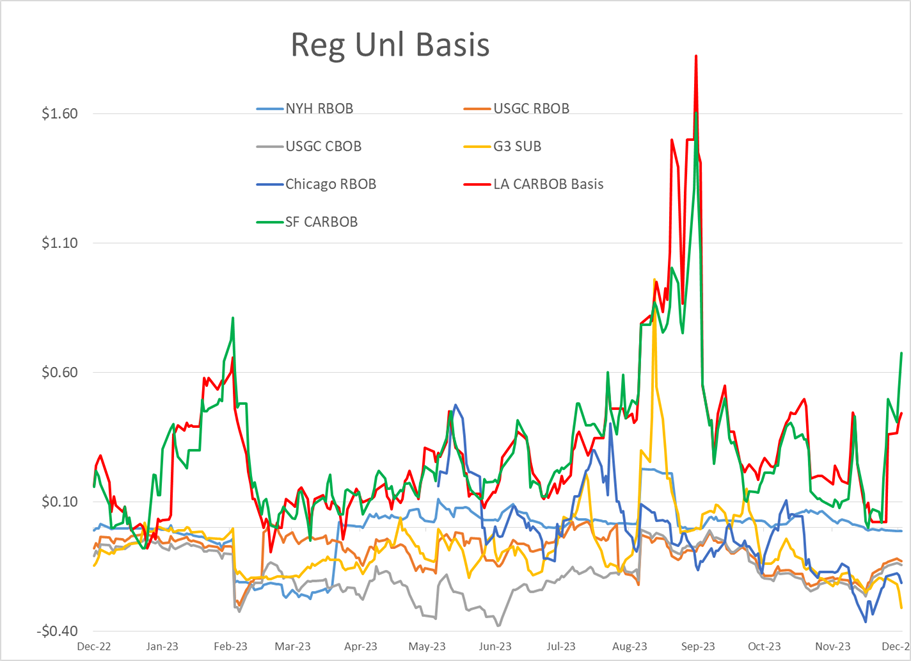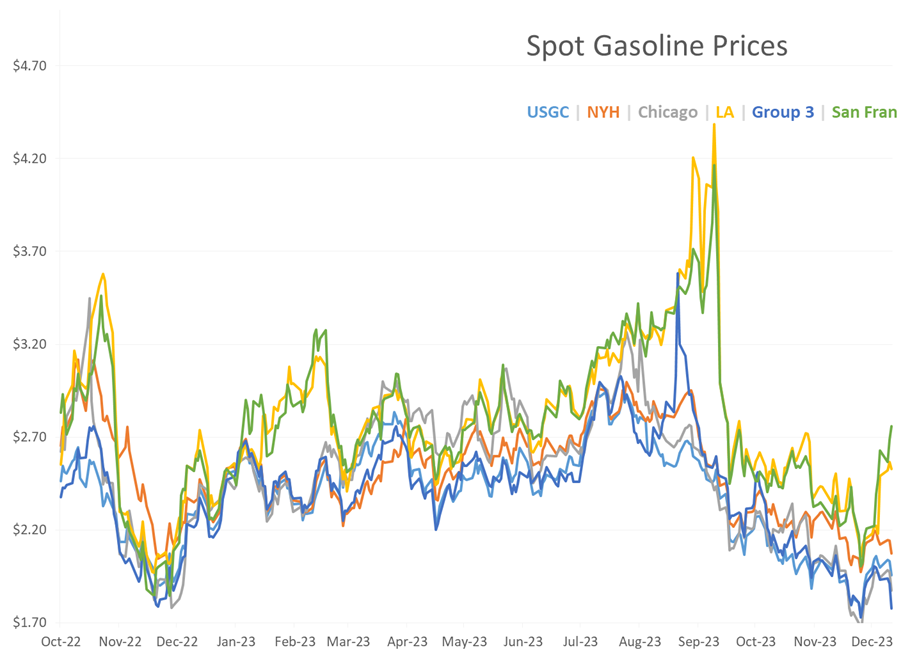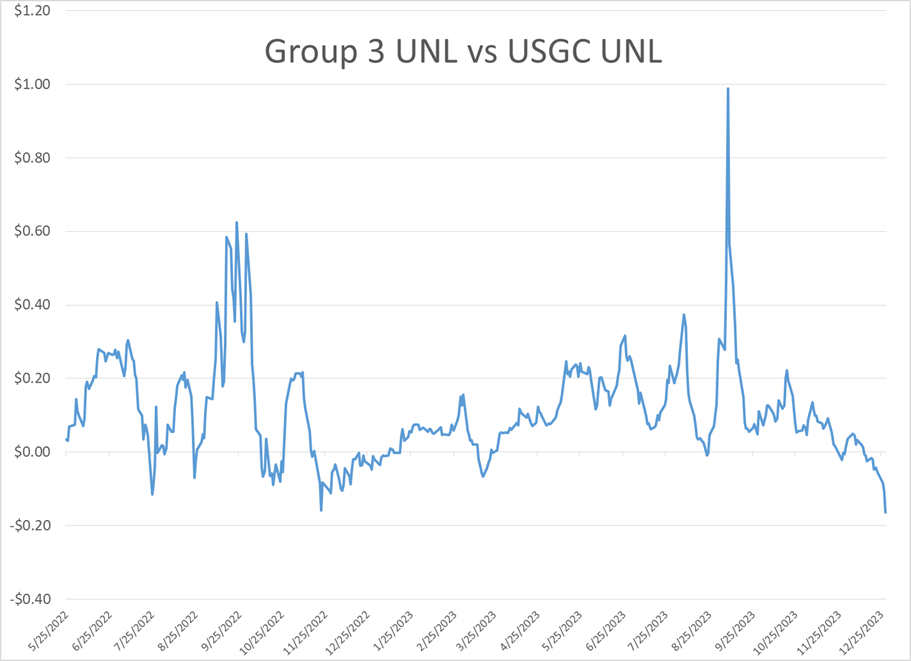It’s The Last Trading Day For 2023, Energy Markets Are Still Searching For Direction With Small Gains For Gasoline And Crude Oil Futures

It’s the last trading day for 2023, and energy markets are still searching for direction with small gains for gasoline and crude oil futures, while diesel sees small losses in the early going. We saw heavy selling Wednesday after US oil output held at a record high, and refinery runs continued to increase and push inventories higher, but prices still appear range-bound for now.
Looking ahead to 2024, shipping chokepoints will be a major story with the Panama Canal still reduced to roughly 50% of its capacity, which was forcing more ships to transit through the Suez Canal before attacks in the Red Sea diverted many of those shipments. The world’s two other key shipping straits are thankfully quiet for now, but Iran just last week attacked a tanker off of the Indian coast so the Strait of Hormuz could certainly soon come back into the forefront, and it’s not too hard to imagine China could see these canal blockages as the perfect time to take action in the South China Sea which could end up disrupting movements through the Malacca strait.
New refining capacity also looks to be a major needle mover this coming year with the huge new Dangote refinery in Nigeria beginning operations this month, but not yet making on-spec products. Whether that facility and Mexico’s new Dos Bocas refinery can come online in a meaningful way will have a heavy influence on the supply condition of the entire Atlantic basin and could create even bigger swings in the US export market than we saw this year.
The return of contango in oil markets after nearly two years of backwardation will also influence markets around the world as shippers are once again incentivized to store barrels. Note the steady increases in Cushing OK inventories in the charts below for an example of this phenomenon at work. With US exports surging and OPEC struggling to keep its production limited, storage capacity could once again command a premium this year.
In other words, there seems to be plenty of oil production and refining capacity in 2024, but the ability to transport that supply to where it’s needed is much less certain.
Those challenges in transportation are evident within the US as well, with both PADD 2 and 3 showing swelling inventories as refiners crank up run rates, while PADD 1 inventories remain low as the options to ship products to the population centers on the East Coast are limited by pipeline capacity and Jones Act vessel restrictions. The ability for refiners to ship barrels out of the center of the country in whatever way they can continue to be a major story for next year and will likely determine whether or not some facilities are forced to cut runs, particularly if the new refining capacity in Africa starts pushing more barrels from Europe to the East Coast.
So far, facilities in the Mid Con don’t seem intimidated as PADD 2 refinery runs surged to a record high last week, at a time of year when we typically see things slow down. PADD 4 saw a sharp reduction in run rates after yet another operational upset at Suncor’s beleaguered refinery outside of Denver, which is facing new challenges to its air permits that could eventually lead to that facility closing for good.
News & Views
View All
ULSD Futures Are Trading Higher For A 5th Straight Session
Energy prices are trying to rally Thursday as the liquidation cycle that pushed prices to multi-month lows earlier in May appears to have ended and new supply concerns trickle into the market. ULSD Futures are trading higher for a 5th straight session, and although the gains are minor at this point, they do suggest that buyers are willing to jump in near the pivotal technical support layers just below the $2.50 mark, and that the fund liquidation that pushed the HO contract to a net short position for money managers is probably over. RBOB futures are trading 8 cents above Wednesday’s low which also suggests that a buy the dip mentality may be taking hold, and now we’ll just see how long it lasts.
The latest in the drone wars: After a major Russian attack focused on Ukraine’s electricity infrastructure earlier in the week, Ukraine’s drones reportedly struck back hitting a Lukoil fuel terminal near Crimea, and a Gazprom oil refinery more than 1,000 miles from the border.
What feedstock problems? A surge of imports of used cooking oil (UCO) from China to the US, used to make RD with a lower CI score, has several domestic producers crying foul and adds to the long history of fraud surrounding renewables as bad actors try to take advantage of government subsidies.
The excess of Renewable Diesel on the west coast is only adding to the relative weakness of diesel margins for refiners who have watched their distillate cracks erode to the lowest levels since January 2022 over the past few months. A Reuters article this morning highlights the challenges that poses, and it will only get worse if the recent rebound in gasoline margins fails to hold. That excess of renewable production targeting the West Coast is also contributing to California’s LCFS values dropping to multi-year lows this week, which is putting pressure on earnings for companies that races to convert refineries to RD production in recent years.
Speaking of which, HF Sinclair reported another net loss in its renewable segment in Q1, while its traditional refineries followed the recent pattern of decent earnings that were far below year-ago levels.
Energy News Today reported a fire at the HF Sinclair refinery in Anacortes WA Wednesday which seemed to contribute to stronger basis values in the typically illiquid PNW spot market, and some tightening of allocations by suppliers in local terminals. In hopefully unrelated news, the company posted a job opening for an Emergency Response Specialist at that facility just last week.
P66 reported yet another upset at its Borger refinery Wednesday, marking the facility’s 14th TCEQ filing of the year so far. Two different sulfur recovery units were noted as being impacted by the event, but it appears the units were able to restore operations.
Click here to download a PDF of today's TACenergy Market Talk.

Week 18 - US DOE Inventory Recap

Crude Oil, Gasoline, And Diesel Benchmarks Are All Trading >1% Lower To Start The Day
Energy prices are sinking again this morning, albeit with a little more conviction than yesterday’s lackadaisical wilting. Crude oil, gasoline, and diesel benchmarks are all trading >1% lower to start the day with headlines pointing to an across-the-board build in national inventories as the source for this morning’s bearish sentiment. The Department of Energy’s official report is due out at its regular time this morning (9:30am CDT).
WTI has broken below its 100-day moving average this morning as it fleshed out the downward trend that began early last month. While crossing this technical threshold may not be significant in and of itself (it happened multiple times back in February), the fact that it coincides with the weekly and monthly charts also breaking below a handful of their respective moving averages paints a pretty bearish picture in the short term. The door is open for prices to drop down to $75 per barrel in the next couple weeks.
Shortly after the EIA’s weekly data showed U.S. commercial crude inventories surpassing 2023 levels for the first time this year, their monthly short-term energy outlook is forecasting a fall back to the bottom end of the 5-year range by August due to increasing refinery runs over the period. However, afterward the administration expects a rise in inventories into 2025, citing continued production increases and loosening global markets hindering the incentive to send those excess barrels overseas. The agency also cut back their average gas and diesel price forecasts for the first time since February with the biggest reductions in the second and third quarter of this year.
The STEO also featured their famed price prediction for WTI, stating with 95% confidence that the price for crude oil will be between $40 and $140 through 2026.
Need a general indication of the global crude oil supply? Most headlines seem to be covering a shortage of a different type of oil, one that we haven’t turned into fuel (yet).
Click here to download a PDF of today's TACenergy Market Talk.
